Takeaway: Even if you’ve engaged in mental health services before, it’s likely that art therapy is totally new to you–as it is to most people. Many people are skeptical about trying art therapy, but it has tons of benefits. Here, I explain what art therapy is and lay out the top benefits of art therapy for mental health-and other unexpected benefits.
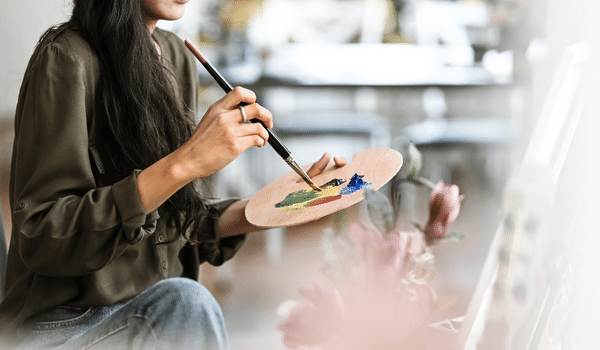
Art therapy can be helpful for people of all ages, experience levels, cultures, and backgrounds. Beyond helping individuals alone, The American Art Therapy Association identifies that art therapy can be useful for families and communities, too.
Art is a powerful, transformative way to heal, communicate, and grow. While many people don’t think of themselves as artists, everyone has a creative side. They just need the opportunity to express it.
Art therapy is just the place to do that. With the help of a licensed art therapist, you can tend to your mental, emotional, physical, social, and spiritual wellness in a whole new way.
What is art therapy?
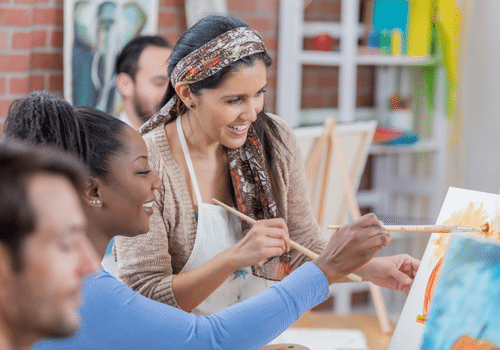
Art therapy is a form of mental health treatment that combines creating art with traditional talk therapy. It uses creative expression to help people process experiences and express feelings in a different way.
Sometimes, words can’t quite capture what we want to convey. Art therapy offers us a wide variety of tools to explore our inner world. Every art therapist is different, and there are many different art forms that therapists use. Painting, collage making, weaving, drawing, coloring, sculpture, and photography are just a few.
Many people feel hesitant about trying art therapy because they are worried about being a “bad” artist. However, making art in therapy isn’t about the end result-it’s about the process. Allowing yourself to be vulnerable and open to the experience can help you get the most out of art therapy.
Who can become an art therapist?
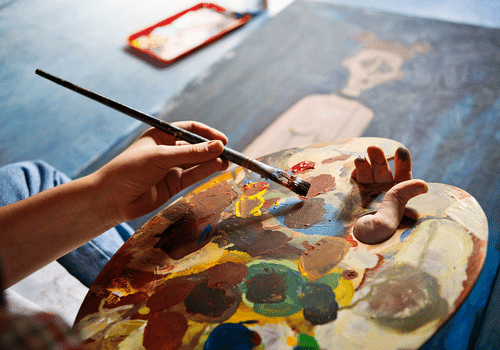
Art therapists need to meet certain educational, experiential, and ethical requirements in order to earn their professional credentials. Requirements also vary between states and organizations. For example, New York creative arts therapists must earn a master’s degree from an accredited art therapy program, have 1,000 hours or more of supervised experience, and pass an exam.
The Art Therapy Credentials Board is a national organization that has similar standards for credentialed art therapists. A Registered Art Therapist (ATR) must earn a master’s degree and have supervised experience in the field, while a Board Certified Art Therapist (ATR-BC) must meet all of those requirements and pass an exam.
According to the American Art Therapy Association, art therapists can work in tons of different settings. Some work with individuals in a private practice setting, while others work in hospitals, schools, or inpatient mental health facilities providing group art therapy.
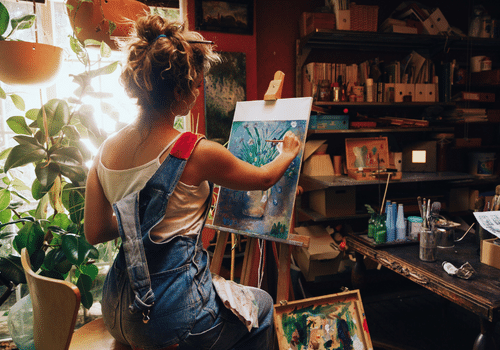
Who is art therapy for?
People of all ages can enjoy the benefit of art therapy. While some people may associate art therapy or art making in general with children, adults deserve to get creative, too.
In fact, it can be incredibly powerful to give yourself the gift of self expression. Oftentimes, we can get caught in old, unhelpful thought patterns that prevent us from growing. Art therapy provides you with the space and creativity to gain new perspectives and insights.
There is no particular issue or diagnosis that art therapy is intended for. People with all sorts of mental illness or physical illness, and different ability levels can benefit from art therapy.
Top benefits of art therapy
The therapeutic benefits you gain from art therapy will depend on your unique experience and goals. With that being said, there are tons of research-backed benefits that you can anticipate-both for your mental wellness and otherwise.
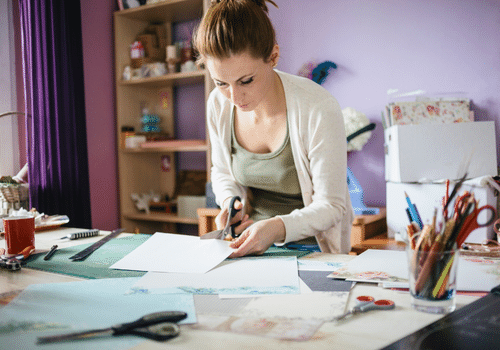
Benefits of art therapy for mental health
Art therapy is used to treat all kinds of psychological symptoms and conditions. People with diagnosed mental illnesses can benefit, as can people who simply want to improve their psychological health. Here are just a few of the mental health benefits of art therapy.
Improve anxiety
According to the National Alliance on Mental Illness (NAMI), anxiety disorders are the most common mental disorders in the United States-nearly 1 in 5 people have an anxiety disorder. Thankfully, there are tons of great treatment options-including art therapy. Studies show that art therapy can improve anxiety symptoms.
Heal from post traumatic stress disorder
Experiencing a traumatic event can change the way you think, feel, and act. However, it is possible to heal. Research suggests that art therapy can help improve PTSD symptoms. Art therapy sessions can give people the time and space to process their trauma in a new way.
Improve personality disorder symptoms
People with personality disorders often have difficulties with self image, emotional regulation, and relationships. Art therapy may be able to help alleviate symptoms for people with personality disorders.
One study demonstrated that participants felt they had improved self awareness, increased emotional stability, and improved communication after engaging in an art therapy treatment process.
Decrease depression symptoms
Depression is another common mental health concern-about 21 million Americans have experienced a depressive episode. There are many different treatment options for depression. Research findings suggest that art therapy can help improve depression symptoms.
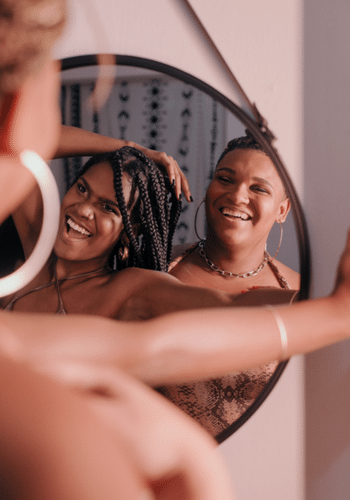
Boost self esteem
Art therapy has been shown to improve self esteem. Though the exact cause is unclear, there are many possibilities for why it can increase confidence. Perhaps people feel good about themselves for trying something new or expressing themselves in a different way, or perhaps art therapy helps them break down unhelpful thinking patterns that contribute to low self esteem.
Help with Alzheimer’s Disease
By selecting art experiences from the person’s past, the creative arts therapist can trigger short and long term memory, decrease agitation, and enhance reality orientation, making the difference between demoralization and dignity.
Help with Chronic Illness
Planning art experiences that distract people from pain and facilitate needed relaxation allows you to move away from chronic pain towards comfort.
Help with Head Injuries
Organizing arts experiences to encourage self-expression, communication and socialization, and to facilitate cognitive retraining can make a difference between isolation and interaction.
Recover from Substance Abuse Problems
Using art-based techniques to confront the client’s barriers and encourage the recovery process, guiding the client through a process that goes from denial towards determination and change.
Promote Rehabilitative Goals for Physical Disabilities
Licensed creative arts therapies can design arts experiences to promote rehabilitative goals and to increase motivation to take the person from frustration and fulfillment.
Help with Developmental Disabilities
Creative arts therapy sessions can be structured to teach cognitive, motor, and daily living skills, providing the opportunity to experience success through the arts.
Other art therapy benefits
Though some people might assume that art therapy is strictly for improving mental well being, the benefits of art therapy go beyond that. Working with an art therapist can help in tons of other areas of your life, including cognitive, social, and physical well being-just to name a few.
Foster self expression
All mental health care is meant to be nonjudgmental. However, art therapy in particular focuses on freedom of expression by being vulnerable in the creative process. In fact, art therapy can help people communicate their thoughts and feelings openly through artistic expression.
Boost problem solving skills
When engaged in creative activities, you might use different parts of your brain than you would otherwise. This can help you learn new ways of thinking and processing. Research even suggests that art therapy helps increase problem solving skills.
Increase cognitive and sensorimotor functions
Art therapy engages your brain and body. It challenges your brain to process and express information differently, as well as take in new information through your senses. Of course, motor skills are also vital for creating art. Studies show that art therapy can even help stroke patients improve both motor skills and cognitive impairment.
Improve social skills

Creating art with another person encourages positive interaction. Using visual arts also allows people to express themselves in ways that go beyond verbal communication. These reasons and more may contribute to how art therapy can improve social function.
Boost physical health
Art therapy can even have an important impact on a person’s physical health. This form of treatment has been shown to help people with a number of physical conditions. Here are just a few examples of the ways that art therapy can help people with certain issues:
- Reduce pain and stress in adults who have cancer
- Help children with cancer improve their ability to cope with pain and stress
- Reduce stress and anxiety symptoms in children with asthma
Public health implications
Since art therapy seems to have such a positive effect on individuals’ mental and physical well being, research suggests that there are public health implications for this form of therapy. If more people are able to access art therapy services, there could be potential benefits on a population level.
Creative Release
Stimulating the creative side of the brain through art making activities and exploration can provide you with a strong sense of self-satisfaction, confidence and tranquility.
Emotional Resilience and Self-Management
Stimulating the creative side of the brain through art making activities and exploration can provide you with a strong sense of self-satisfaction, confidence and tranquility.
Are there any drawbacks to art therapy?
While there are tons of therapeutic benefits to art therapy, it’s also important to note that each individual has a different experience. While art therapy isn’t inherently harmful (in fact, quite the opposite), there are always potentially positive and potentially negative factors to consider.
One survey showed that while many people generally have a positive view of art therapy, they also have valid concerns. For example, some people worried about the negative emotions that may arise during art therapy.
As with any kind of therapy approach, there is always the possibility-even the likelihood-of negative symptoms or feelings coming up. Therapy is a vulnerable process, and it involves getting in touch with painful experiences, worries, or difficult emotions. Your therapist will work closely with you to make sure that you have the skills you need to self soothe.
The survey participants also had concerns about creating a supportive relationship with their therapist. Generally, professionals and the general public alike agree that a strong therapeutic connection is essential for the healing process. Without this, it might be difficult to reach your goals in therapy.
This is a totally valid concern. It’s important to work with a therapist who you feel comfortable with, and who provides you with support and encouragement. It can take time to find a therapist you really connect with, so don’t be afraid to keep looking if you don’t gel with the first therapist you find.
Embrace the creative process with the help of an art therapist in NYC

As an art therapist in NYC, I help people embrace the messiness of being human. My clients come to me with anxiety, emotional trauma, and relationship struggles. Together, we use art as a healthy outlet for processing difficult experiences, getting clarity on what matters to you, and learning new ways to cope.
Keep in mind that you don’t have to be a great artist to benefit from art therapy. In fact, it’s often more helpful (and fun!) if you relinquish this pressure to be “good” or “perfect” and just let yourself experience the creative process.
There’s also no pressure to make each appointment an art therapy session. We can use art as a tool if that feels good. If other tools or treatments feel more right, that’s great, too. You’re also allowed to change your mind at any time-you’re in the driver’s seat.
I’d be honored to assist in your journey of self discovery. If you feel we might be a good fit for each other, I encourage you to reach out. During your free 20-minute consultation, we can address any questions you might have and talk more about the therapeutic process. I hope to hear from you soon!
